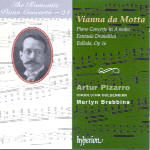Best known for the international piano competition that bears his name, José Vianna da Motta (1868-1948) was one of Liszt’s last pupils and was a noted pianist and educator in his native Portugal. He left a large compositional output, of which the 1895 Symphony “To the Fatherland” gained the most renown. Vianna da Motta found smaller forms particularly congenial, and his numerous shorter piano pieces are most attractive for their nationalistic charm. The 19-year-old composer’s A major Piano Concerto owes a lot to Liszt’s own concerto in the same key, with allusions to Brahms’ thicker textures (the trills and double notes throughout the Largo and Variations movement). And the third variation’s aphoristic woodwind passages foreshadow those in Richard Strauss’ Burleske for Piano and Orchestra. Vianna da Motta’s musical ideas fall into predictable foursquare patterns that cancel each other out as the music proceeds without really progressing anywhere. The Fantasia Dramatica from 1893 is scarcely more memorable, even if the first movement boasts some lovely harmonic sequences (not enough to entirely offset the music’s lackluster rhythmic impetus).
At least Artur Pizarro thrives on the piano writing’s prodigious demands, notably in the solo Ballada’s vertigo-inducing left-hand chromatic runs. Save for patches of thinnish string tone and a teensy horn blooper at the top of the A major concerto’s second movement, the Gulbenkian Orchestra plays well under Martyn Brabbins’ leadership. My rating, therefore, reflects my response to the performance and sound quality, and not the music’s merits. Great music it’s not, but you have to hand it to Hyperion for letting us hear these rarities as part of the label’s ongoing Romantic Piano Concerto survey.
































